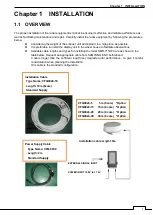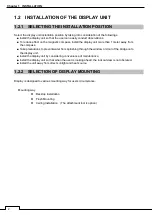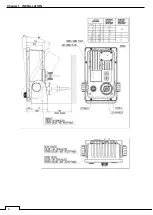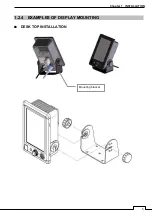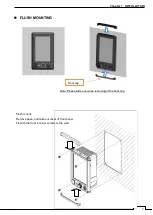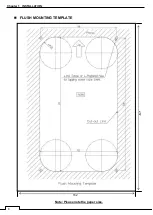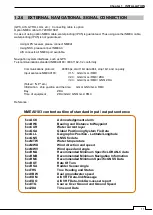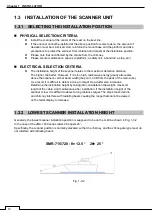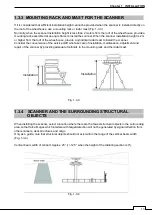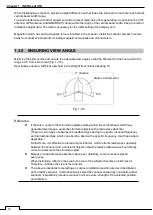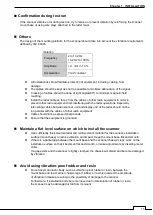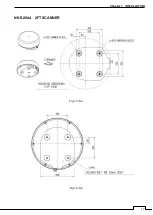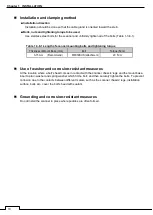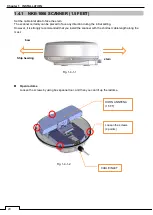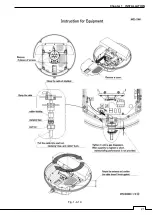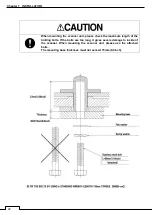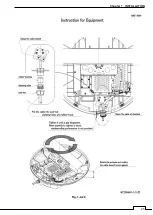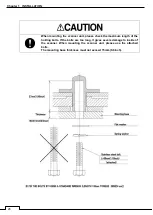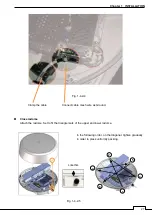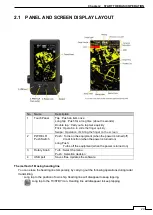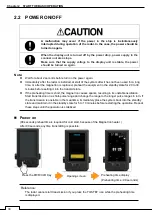
Chapter 1 INSTALLATION
15
■
Confirmation during test run
If the scanner vibrates a lot during test run, try to reduce or prevent vibration by reinforcing the scanner
mount base or using wire stays attached to the radar mast.
Others
The design of the mounting platform for the scanner should take into account the
vibration requirements
defined by IEC 60945.
Vibration
Frequency
2 to 13.2 Hz
13.2 Hz to 100 Hz
Amplitude
+/-1 mm +/-10 %
Acceleration
7m/s
2
constant
All installations should facilitate protection of equipment, including cabling, from
damage.
The cables should be kept as short as possible to minimize attenuation of the signal.
Crossing of cables should be done at right angles(90°) to minimize magnetic field
coupling.
Install the radar cable as far as from the cables of other radio equipment in order to
prevent other radio equipment from interfering with the radar operations. Especially
inter-wiring cables between scanner unit and display unit of the radar should not be
run parallel with the cables of other radio equipment.
Cable should not be exposed sharp bends.
Ensure that the equipment is grounded.
Maintain a flat level surface on which to install the scanner
Use sufficiently thick steel material and reinforcement material for the scanner's installation
surface (mount base) to reduce vibration and impact. Keep the mount base flat and smooth.
If there is a partial gap between the mount base and the scanner chassis's legs, work on the
installation surface so that it becomes flat and smooth, or make adjustments by inserting metal
shims.
If a gap exists and the scanner is tightly clamped, the chassis will distort and become damaged
by vibration.
Avoid using vibration-proof rubber and resin
Do not insert an elastic body, such as vibration-proof rubber or resin, between the
mount base and the scanner chassis legs. If rubber or resin is inserted, the amplitude
of vibration increases, resulting in the possibility of damage to the scanner.
Furthermore, if installation bolts become loose due to deterioration of rubber or resin,
the scanner may be damaged or fall from its mount
Summary of Contents for SMR-715 series
Page 1: ...MARINE RADAR EQUIPMENT INSTRUCTION MANUAL...
Page 2: ......
Page 15: ...xiii EQUIPMENT APPEARANCE NKE 1066 SCANNER UNIT NKE 2044 SCANNER UNIT...
Page 29: ...Chapter 1 INSTALLATION 3 1 2 3 DIMENSIONAL DRAWING OF DISPLAY MOUNTING...
Page 30: ...Chapter 1 INSTALLATION 4...
Page 32: ...Chapter 1 INSTALLATION 6 DESKTOP MOUNTING TEMPLATE Note Please note the paper size 182 257...
Page 34: ...Chapter 1 INSTALLATION 8 FLUSH MOUNTING TEMPLATE Note Please note the paper size 182 257...
Page 43: ...Chapter 1 INSTALLATION 17 NKE 2044 2FT SCANNER Fig 1 3 6 3 Fig 1 3 6 4...
Page 47: ...Chapter 1 INSTALLATION 21 Fig 1 4 1 3...
Page 51: ...Chapter 1 INSTALLATION 25 Fig 1 4 2 3...
Page 157: ...131 Chapter 10 AFTER SALE SERVICE 10 4 RADAR FAILURE CHECK LIST SMR...
Page 159: ...133 Chapter 12 SPECIFICATIONS Chapter 12 SPECIFICATIONS...
Page 160: ...134 Chapter 12 SPECIFICATIONS 12 1 SCANNER DIMENSION 12 1 1 NKE 1066 4 40 RUBBER PLATE...
Page 161: ...135 Chapter 12 SPECIFICATIONS 12 1 2 NKE 2044...
Page 162: ...136 Chapter 12 SPECIFICATIONS 12 2 DISPLAY DIMENSION 12 2 1 SMR 715 720...
Page 163: ...137 Chapter 12 SPECIFICATIONS...
Page 172: ...APPENDIX A 1 APPENDIX NKE 1066 1 5FT SCANNER INTERCONNECTION DIAGRAM FIG A1...
Page 173: ...APPENDIX A 2 NKE 2044 2FT SCANNER INTERCONNECTION DIAGRAM FIG A2...
Page 174: ...APPENDIX A 3 SMR 715 720 DISPLAY UNIT INTER CONNECTION DIAGRAM FIG A3...
Page 175: ...APPENDIX A 4 SMR 715 720 PRIMARY POWER SUPPLY DIAGRAM FIG A4...
Page 176: ...APPENDIX A 5 SMR 715 720 INTERCONNECTION DIAGRAM FIG A5...
Page 177: ...APPENDIX A 6 MEMO...
Page 187: ...APPENDIX A 16 DECLARATION OF CONFORMITY...
Page 188: ...APPENDIX A 17...
Page 189: ...APPENDIX...
Page 191: ...Chapter 3 ADJUST THE RADAR ECHO A 2...
Page 192: ...Chapter 3 ADJUST THE RADAR ECHO...

